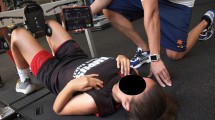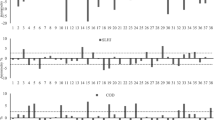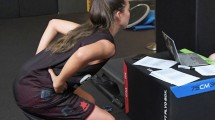Abstract
Background
Enhanced muscular strength has been widely acknowledged as a fundamental determinant of improved performance in the lower extremities. However, the specific impact of ankle strength on explosive strength and balance remains inadequately elucidated. Consequently, this study aims to (a) evaluate balance, reactive power, and flexor–extensor muscle balances in soccer players, and (b) evaluate ankle dorsal and plantar flexion muscle strength as predictive factors for reactive strength index and balance performance.
Methodology
A cohort comprising 38 actively engaged Turkish National League soccer players participated in the study. The assessment encompassed explosive power through a drop jump, dynamic balance utilizing a moving disc, and ankle strength measured with a handheld dynamometer.
Results
The findings revealed that dominant lower limb dorsal flexion strength emerged as a significant predictor of both reactive strength (R2 = 0.106, p < 0.05) and balance (R2 = 0.121, p < 0.05). Similarly, non-dominant lower limb dorsal flexion strength was identified as a significant predictor of reactive strength (R2 = 0.362, p < 0.05). Furthermore, the study established that dominant lower limb plantar flexion strength significantly predicted balance (R2 = 0.121, p < 0.05), while non-dominant lower limb plantar flexion strength served as a significant predictor of both reactive strength (R2 = 0.148, p < 0.05) and balance (R2 = 0.179, p < 0.05).
Conclusions
Consequently, these findings emphasize the significance of incorporating targeted exercises designed to enhance intrinsic foot musculature, thereby augmenting both explosive strength and balance in athletes. While acknowledging the persistent importance of strength assessment in evaluating lower extremity performance, our results underscore the critical role played by ankle muscle strength in the execution of explosive strength and balance.





Similar content being viewed by others
Data availability
The data that support the findings of this study are available on request from the corresponding author.
References
Chinn L, Hertel J (2010) Rehabilitation of ankle and foot injuries in athletes. Clin Sports Med 29:157–167
O’Loughlin PF, Murawski CD, Egan C, Kennedy JG (2009) Ankle instability in sports. Phys Sportsmed 37:93–103
Harput G (2020) Kinesiology of the knee joint. In: Comparative kinesiology of the human body. Elsevier, pp 393–410
Bhuyan D, Kumar K (2021) Design of a prosthetic ankle complex: a study in biomimetic system design. In: Research anthology on emerging technologies and ethical implications in human enhancement. IGI Global, pp 381–399
Weineck J, Kemmler W, Fröhlich M (2023) Trainingsziele,-Inhalte,-Mittel Und-Methoden Im Sport. In: Bewegung, Training, Leistung und Gesundheit: Handbuch Sport und Sportwissenschaft. Springer, pp 757–769
Lalevée M, Anderson DD, Wilken JM (2023) Current challenges in chronic ankle instability: review and perspective. Foot Ankle Clin 28:129–143
Bruening DA, Pohl MB, Takahashi KZ, Barrios JA (2018) Midtarsal locking, the windlass mechanism, and running strike pattern: a kinematic and kinetic assessment. J Biomech 73:185–191
Kelly LA, Cresswell AG, Farris DJ (2018) The energetic behaviour of the human foot across a range of running speeds. Sci Rep 8:10576
Stearne SM, McDonald KA, Alderson JA, North I, Oxnard CE, Rubenson J (2016) The foot’s arch and the energetics of human locomotion. Sci Rep 6:19403
Kelly LA, Farris DJ, Cresswell AG, Lichtwark GA (2019) Intrinsic foot muscles contribute to elastic energy storage and return in the human foot. J Appl Physiol 126:231–238
Smith RE, Lichtwark GA, Kelly LA (2022) Flexor digitorum brevis utilizes elastic strain energy to contribute to both work generation and energy absorption at the foot. J Exp Biol 225:jeb243792
Smith RE, Lichtwark GA, Kelly LA (2021) The energetic function of the human foot and its muscles during accelerations and decelerations. J Exp Biol 224:jeb242263
Hiller CE, Beckenkamp PR (2023) Effect of braces on performance in the context of chronic ankle instability. Foot Ankle Clin 28:145–154
Wirtz N, Dörmann U, Micke F, Filipovic A, Kleinöder H, Donath L (2019) Effects of whole-body electromyostimulation on strength-, sprint-, and jump performance in moderately trained young adults: a mini-meta-analysis of five homogenous RCTs of our work group. Front Physiol 10:1336
Bobbert MF, Lindberg K, Bjørnsen T, Solberg P, Paulsen G (2023) The force-velocity profile for jumping: what it is and what it is not. Med Sci Sports Exerc 55:1241
Ly K, Michaud L, Lajoie Y (2021) The effects of kinesiology tape on static postural control in individuals with functional ankle instability. Phys Ther Sport 48:146–153
Ma T, Li Q, Song Y, Hua Y (2021) Chronic ankle instability is associated with proprioception deficits: a systematic review and meta-analysis. J Sport Health Sci 10:182–191
Wan B (2023) How to effectively improve the physical fitness training of college football. Acad J Manag Soc Sci 3:84–87
Van Dyk N, Bahr R, Whiteley R, Tol JL, Kumar BD, Hamilton B, Farooq A, Witvrouw E (2016) Hamstring and quadriceps isokinetic strength deficits are weak risk factors for hamstring strain injuries: a 4-year cohort study. Am J Sports Med 44:1789–1795
McKeon PO, Fourchet F (2015) Freeing the foot: integrating the foot core system into rehabilitation for lower extremity injuries. Clin Sports Med 34:347–361
Trinidad-Fernandez M, Gonzalez-Sanchez M, Cuesta-Vargas AI (2019) Is a low functional movement screen score (≤ 14/21) associated with injuries in sport? A systematic review and meta-analysis. BMJ Open Sport Exerc Med 5:e000501
Walls RJ, Ross KA, Fraser EJ, Hodgkins CW, Smyth NA, Egan CJ, Calder J, Kennedy JG (2016) Football injuries of the ankle: a review of injury mechanisms, diagnosis and management. World J Orthop 7:8
Bompa T, Buzzichelli C (2015) Periodization Training for Sports, 3e, Human kinetics. ISBN 1450469434
Vargas S, Petro JL, Romance R, Bonilla DA, Florido MÁ, Kreider RB, Schoenfeld BJ, Benitez-Porres J (2019) Comparison of changes in lean body mass with a strength-versus muscle endurance-based resistance training program. Eur J Appl Physiol 119:933–940
Gribble PA, Hertel J, Denegar CR (2006) Chronic ankle instability and fatigue create proximal joint alterations during performance of the star excursion balance test. Int J Sports Med 28:236–242
Jeon K, Kim T, Lee S-H (2016) Effects of muscle extension strength exercise on trunk muscle strength and stability of patients with lumbar herniated nucleus pulposus. J Phys Ther Sci 28:1418–1421
Fousekis K, Tsepis E, Vagenas G (2010) Lower limb strength in professional soccer players: profile, asymmetry, and training age. J Sports Sci Med 9:364
Otsuka M, Yamauchi J, Kurihara T, Morita N, Isaka T (2015) Toe flexor strength and lower-limb physical performance in adolescent. Gazz Med Ital 174:307–313
Hildebrandt M (2015) Smart technologies and the end (s) of law: novel entanglements of law and technology. Edward Elgar Publishing, ISBN 1849808775
Kenny IC, Cairealláin AÓ, Comyns TM (2012) Validation of an electronic jump mat to assess stretch-shortening cycle function. J Strength Cond Res 26:1601–1608
Aramaki H, Katoh M, Hiiragi Y, Kawasaki T, Kurihara T, Ohmi Y (2016) Validity and reliability of isometric muscle strength measurements of hip abduction and abduction with external hip rotation in a bent-hip position using a handheld dynamometer with a belt. J Phys Ther Sci 28:2123–2127
Kimura M, Ogata Y, Akebi T, Ochi M, Hachisuka K, Saeki S (2018) Development and reliability of a hand-held dynamometer device to measure the ankle dorsiflexor muscle strength. J Rehabil Assist Technol Eng 5:2055668318802558
Spink MJ, Fotoohabadi MR, Menz HB (2010) Foot and ankle strength assessment using hand-held dynamometry: reliability and age-related differences. Gerontology 56:525–532
Al Abdulwahab SS, Kachanathu SJ (2015) The effect of various degrees of foot posture on standing balance in a healthy adult population. Somatosens Mot Res 32:172–176
Trajković N, Kozinc Ž, Smajla D, Šarabon N (2021) Relationship between ankle strength and range of motion and postural stability during single-leg quiet stance in trained athletes. Sci Rep 11:11749
Huang P-Y, Jankaew A, Lin C-F (2021) Effects of plyometric and balance training on neuromuscular control of recreational athletes with functional ankle instability: a randomized controlled laboratory study. Int J Environ Res Public Health 18:5269
Li R, Qin R, Tan Y, Liu H, Wang K, Cheng L (2023) Effect of kinesio taping intervention on the muscle strength and balance of college basketball players with functional ankle instability. Front Physiol 14:1064625
Seo JH, Lee MY (2022) Effects of quarter heel raising exercise on balance and ankle strength in functional ankle instability subjects. Medicine 101:e30672
Kuczyński M, Szymańska M, Bieć E (2011) Dual-task effect on postural control in high-level competitive dancers. J Sports Sci 29:539–545
Beijersbergen CMI, Granacher U, Vandervoort AA, DeVita P, Hortobágyi T (2013) The biomechanical mechanism of how strength and power training improves walking speed in old adults remains unknown. Ageing Res Rev 12:618–627
Watanabe T, Saito K, Ishida K, Tanabe S, Nojima I (2018) Coordination of plantar flexor muscles during bipedal and unipedal stances in young and elderly adults. Exp Brain Res 236:1229–1239
Koushyar H, Bieryla KA, Nussbaum MA, Madigan ML (2019) Age-related strength loss affects non-stepping balance recovery. PLoS ONE 14:e0210049
Hamner SR, Seth A, Delp SL (2010) Muscle contributions to propulsion and support during running. J Biomech 43:2709–2716
Yaggie JA, McGregor SJ (2002) Effects of isokinetic ankle fatigue on the maintenance of balance and postural limits. Arch Phys Med Rehabil 83:224–228
Jung D-Y, Koh E-K, Kwon O-Y (2011) Effect of foot orthoses and short-foot exercise on the cross-sectional area of the abductor hallucis muscle in subjects with pes planus: a randomized controlled trial. J Back Musculoskelet Rehabil 24:225–231
Suzuki Y, Murata M (2020) Comparison of translational momentum and mechanical energy produced by lower limb muscles between horizontal and vertical jumps—a computer simulation study. Int J Sport Health Sci 18:207–214
Kozinc Ž, Šarabon N (2022) Measurements of lower-limb isometric single-joint maximal voluntary torque and rate of torque development capacity offer limited insight into vertical jumping performance. Meas Phys Educ Exerc Sci 26:15–26
Mohammadi Nia Samakosh H, Brito JP, Shojaedin SS, Hadadnezhad M, Oliveira R (2022) What does provide better effects on balance, strength, and lower extremity muscle function in professional male soccer players with chronic ankle instability? Hopping or a balance plus strength intervention? A randomized control study. In: Proceedings of the healthcare, MDPI, vol 10, p 1822
Panoutsakopoulos V, Kotzamanidou MC, Giannakos AK, Kollias IA (2022) Relationship of vertical jump performance and ankle joint range of motion: effect of knee joint angle and handedness in young adult handball players. Sports 10:86
Grozier CD, Cagle GK, Pantone L, Rank KB, Wilson SJ, Harry JR, Seals S, Simpson JD (2021) Effects of medial longitudinal arch flexibility on propulsion kinetics during drop vertical jumps. J Biomech 118:110322
Cen X, Xu D, Baker JS, Gu Y (2020) Association of arch stiffness with plantar impulse distribution during walking, running, and gait termination. Int J Environ Res Public Health 17:2090
Takahashi KZ, Gross MT, Van Werkhoven H, Piazza SJ, Sawicki GS (2016) Adding stiffness to the foot modulates soleus force-velocity behaviour during human walking. Sci Rep 6:29870
Tourillon R, Six A, Bothorel H, Fourchet F (2023) Are foot posture and morphological deformation associated with ankle plantar flexion isokinetic strength and vertical drop jump kinetics? A principal component analysis. Sports Biomech 1–15
Pandy MG, Lai AKM, Schache AG, Lin Y (2021) How muscles maximize performance in accelerated sprinting. Scand J Med Sci Sports 31:1882–1896
Acknowledgements
This study was supported by the BAP Coordination Unit of Recep Tayyip Erdogan University (Number: TSA-2022-1360). We thank to their support.
Funding
The present study was not supported by any funding.
Author information
Authors and Affiliations
Contributions
Conceptualization, R.F.K.; methodology, R.F.K., E.T., S.B., H.İ.C.; formal analysis, R.F.K.; investigation, S.B., H.İ.C.; writing—original draft preparation, R.F.K, E.T., S.B., H.İ.C., R.M., P.T.N.; writing—review and editing, R.F.K, E.T., S.B., H.İ.C., R.M., P.T.N.; supervision, H.İ.C.; All authors have read and agreed to the published version of the manuscript.
Corresponding author
Ethics declarations
Conflict of interest
The authors declare no conflict of interest..
Ethics approval and consent to participate
The study was approved by the Recep Tayyip Erdogan University Non-Interventional Clinical Research Ethics Committee (Number: E-40465587-050.01.04-148, Date: 24/06/2021). Written informed consent to participate in this study was provided by the participant’s legal guardian/next of kin. Informed consent was obtained from all individual participants included in the study.
Consent for publication
Not applicable.
Additional information
Publisher's Note
Springer Nature remains neutral with regard to jurisdictional claims in published maps and institutional affiliations.
Rights and permissions
Springer Nature or its licensor (e.g. a society or other partner) holds exclusive rights to this article under a publishing agreement with the author(s) or other rightsholder(s); author self-archiving of the accepted manuscript version of this article is solely governed by the terms of such publishing agreement and applicable law.
About this article
Cite this article
Kayhan, R.F., Terzi, E., Bayrakdaroğlu, S. et al. Exploring the associations between ankle dorsal and plantar flexion strength, reactive strength index, and balance in elite youth soccer players. Sport Sci Health (2024). https://doi.org/10.1007/s11332-024-01207-7
Received:
Accepted:
Published:
DOI: https://doi.org/10.1007/s11332-024-01207-7




